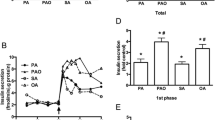Abstract
Using rat hepatocytes we confirmed our previous results that glucagon and β-adrenergic agonists increased the enzyme activity of alanine aminotransferase (AAT) and propranolol abolished their effects. Only the enzyme activity was measured and other parameters like quantity of the enzyme or activation due to modification were not looked for. As in perfusion experiment phenylephrine and phenoxybenzamine (α-agonist and α-antagonist respectively) also increased the AAT activity in isolated rat hepatocytes and propranolol reversed these effects. The additive effect of glucagon and phenoxybenzamine on AAT was also persistant in hepatocyte system.
Fructose- 1:6-bisphosphatase (Fru-P2ase), another key enzyme in gluconeogenic pathway, was elevated by glucagon and other β-adrenergic agonists both in liver perfusion and isolated hepatocyte experiments and was brought back to the normal level by propranolol. In this case also only the enzyme activity was measured and no other parameters were looked for. Unlike AAT this enzyme was not stimulated by phenylephrine or phenoxybenzamine. But AAT and Fru-P2-ase activities were increased significantly by adenylate cyclase activators like fluoride or forskolin. Thus, it appears that the regulation of fru-P2-ase by glucagon is purely a β-receptor mediated process whereas AAT activation shows a mixed type of regulation where some well known α-agonist and antagonists are behaving as β-agonists.
Results further indicate the presence of phosphodiesterase in hepatocyte membrane which was stimulated by glucagon and brought back to the normal level by propranolol.
The different adrenergic compounds stated above, not only modified the activity of the above two enzymes but also stimulated glucose production by hepatocytes from alanine which was in turn abolished by propranolol as well as amino oxyacetate (AOA), a highly specified inhibitor of AAT. This confirm the participation of AAT in gluconeogenesis from alanine in liver. Forskolin and fluoride also increased the glucose production from alanine and showed additive effects with glucagon, phenylephrine and phenoxybenzamine.
Similar content being viewed by others
References
Begum NA, Datta AG: Effect of glucagon and some other alpha and beta adrenergic agonists and antagonists on alanine aminotransferase of perfused rat liver. Mol Cell Biochem 105: 7–13, 1991
Taunton OD, Stifell FB, Greene HL, Herman RH: Rapid reciprocal changes of rat hepatic glycolytic enzymes and fructose-1:6bisphosphatase following glucagon and insulin injection in vivo. Biochem Biophys Res Commun 48: 1663–1670, 1972
Chatterjee T, Datta AG: Effect of glucagon administration on mice liver fructose- 1:6-bisphosphatase. Biochem Biophys Res Commun 84: 950–956, 1978
Mallette LE, Exton JH, Park CR: Control of gluconeogenesis from amino acids in the perfused rat liver. J Biol Chem 244: 5713–5723, 1969
McGivan JD, Ramsell JC, Lacy JH: Stimulation of alanine transport and metabolism by dcAMP in the hepatocytes from fed rat. Biochim Biophys Acta 644: 295–304, 1981
Segal JL, Matsuzawa T: L-alanine aminotransferase (rat liver). In: H Tabor and GW Tabor (eds) Methods in Enzymology. Academic Press, New York and London, 1970, pp 153–159, vol 17A
Racker E: Fructose-1:6-bisphosphatase from Spinach Leaves. In: SP Colwick and NO Kaplan (eds) Methods in Enzymology, Academic Press, New York, 1962, pp. 272–276, vol 5
Rubin CS, Schwartz D, Rangel-Aldao R: Rapid assay for cyclic AMP and cyclic GMP phosphodiesterases. Anal Biochem 87: 367–375, 1978
Bernt E, Bergmeyer HU: Determination of glucose with glucose oxidase and peroxidase. In: HU Bergmeyer (ed) Methods of enzymatic analysis. Academic Press, New York, 1965, pp 123–129
Fuin JN: Adenylate cyclase. In Receptors and recognition, series A6, Edited by P Cuatrecasas and MF Greaves. Chapman and Hall Ltd, 11 New Fetter Lane, London EC4P 4EE, pp 9–30, 1978
Richard CS, Furuya E, Uyeda K: Regulation of fructose-2:6-P2 concentration in isolated hepatocytes. Biochem Biophys Res Commun 100: 1673–1679, 1981
Weiner N: Drugs that inhibit adrenergic nerves and block adrenergic receptors. In: AG Gilman, LS Goodman and A Gilman (eds) The Pharmacological basis of therapeutics. Macmillan Publishing Co., INC, 1980 pp 176–210, Edition 6
Guissell DO, Banzer KA, Laffertty JC: Role of calcium and cAMP in the regulation of rat submandibular mucin secretion. Am J Physiol 241: C76-C85, 1981
Gardy T, Fickora M, Howards ST: Stimulation and inhibition of cAMP accumulation by glucagon in canine hepatocytes. J Biol Chem 262: 15514–15520, 1987
Jefry MS, Robert JL: In: The beta adrenergic receptor, (eds) Current topics in membrane and transport, Academic Press, INC, 1983, pp 46–63, vol 18
Fain JN, Butcher FR, Tolbert MEM: Lack of correlation between catecholamine effects on cyclic adenosine 3′:5′-monophosphate and gluconeogenesis in isolated rat liver cells. J Biol Chem 248: 5686–5692, 1973
Exton JH, Park CR, Corbin JD, Harper SC, Assimacopoulos FD, Cherrington AD: Studies on the a-adrenergic activation of hepatic glucose output. J Biol Chem 251: 5209–5218, 1976
Ganzalez-Mancho'n C, Sanchez-Ayuso M, Parrilla R: Control of gluconeogenesis: Role of fatty acids in a-adrenergic response. Biochim Biophys Acta 972: 192–199, 1988
Williamson JR, Cooper RH, Hock JB: Role of calcium in the hormonal regulation of liver metabolism. Biochim Biophys Acta 639: 243–282, 1981
Mine T, Kojima I, Kimura S, Ogata E: Comparison of the changes in cytoplasmic free calcium concentration induced by phenylephrine, vasopressin and angiotensin II in hepatocytes. Biochem Biophys Res Commun 140: 107–113, 1986
Seamon KB, Dal JW: Forskolin: Its Biological and Chemical Properties. In Advances in Cyclic Nucleotide Research, vol 20, edited by O Greengard and GA Robison. Raven Press, New York, pp 3–138, 1986
Ekman P, Ekdal KN: Effects of epinephrine, glucagon and insulin on the activity and degree of phosphorylation of tructose-1:6-bisphosphatase in cultured hepatocytes. Biochim Biophys Acta 929: 318–326, 1987
Smith SB, Briggs S, Triebwasser KC, Freedland RA: Reevaluation of aminooxyacetate as an inhibitor. Biochem J 162: 453–455, 1977
Author information
Authors and Affiliations
Rights and permissions
About this article
Cite this article
Begum, N.A., Datta, A.G. Effect of adrenergic agonists and antagonists on alanine amino transferase, fructose-1:6-bisphosphatase and glucose production in hepatocytes. Mol Cell Biochem 113, 93–103 (1992). https://doi.org/10.1007/BF00231529
Received:
Accepted:
Issue Date:
DOI: https://doi.org/10.1007/BF00231529




